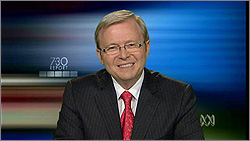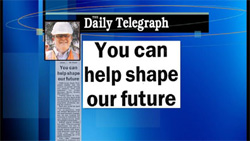
When Chairman Rudd announced the Australia 2020 Summit the euphoria kicked in like a clean hit of a fresh new political drug. After 11 drab years of John Winston Howard, Change! Big, bright colourful change with sparkly bits and the sound of a thousand sitars! But now the euphoria’s wearing off. We’re coming down — and the Main Event is still a month away.
Kevin still looks pretty cheerful, though, doesn’t he. Why is that?
Look back through everything I’ve written so far and you can see the moodswing. “Chairman Rudd’s got a clever strategy going,” my first post began. Another post was headlined Australia, let the Enlightenment begin!, quoting Maxine “Toadslayer” McKew and agreeing that the nation was ready to start a new conversation about its destiny. At the end of February I even nominated myself.
Given Rudd’s claim that his government would be open and transparent, and develop policies based on evidence, it all sounded pretty good.
As days go by, however, it’s become increasingly clear that the potential of the event will be stifled by the political “need” to placate the same old whingeing lobby groups, the same old middle-class middle-aged white men in dark suits (just flick through the Steering Committee) and, it seems, the “need” to pre-load the agenda with specific topics to… well, let’s explore that.
There’s two brilliant critiques of the process so far. Please, read them in full before continuing — though I’ll give you a summary here if you’re in a hurry.
The ABC’s Media Watch ran a story this week, I’m having a Summit and you’re invited, which highlighted Rudd’s technique of openly inviting specific high-profile journalists and getting key media outlets to nominate “ordinary Australians” — ensuring they’d be supportive.
In the past couple of weeks, the Prime Minister’s Office has invited twenty media organisations — they’ve sent us a list — to select a reader, listener or viewer and to pay for them to go to Canberra.
That’s not including News Ltd’s big kahuna, John Hartigan, who of course is chairing one of the summit sessions.
It’s not surprising that News Ltd papers have eagerly joined the search for summiteers.
Like Sydney’s Daily Telegraph…
“You can help shape our future”
— Daily Telegraph, You can help shape our future, 3rd March, 2008
Australia’s 1000 “best and brightest” is gradually diluted.
Meanwhile, the Centre for Policy Development‘s article Beyond the 2020 Summit asks us to imagine what we actually do after this magic weekend.
You would think that the Government’s stated objectives for the Summit would be a good place to start. Here we scrutinise just two: harnessing the best ideas across the nation and producing options for consideration by Government.
Objective: To harness the best ideas across the nation.
This might be difficult to measure and doing so will be a very long-term exercise. For those who missed out on their opportunity to present their ideas at all, it is probably a sore point. Candidates had to write 100 words to justify their inclusion and many with wonderful ideas would not have considered themselves worthy of consideration. From amongst those bold enough to apply, can we be certain that the Steering Committee did not filter out potentially radical ideas in their participant selection process? No matter how open-minded the selectors, it is certain that the Summit was a select group rather than a genuine opportunity to generate the best ideas Australians could offer.
Objective: To produce options for consideration by the Government.
This is hardly a firm commitment to do anything in particular with the ideas. As well, there was a promise that a public response would be produced by the end of 2008. The decision-making process is hardly transparent; it is not clear who will decide which ideas are capable of being shaped into concrete policy responses. This objective, unfortunately, will most likely lead to contributors at the Summit passively awaiting the Government’s response. Moreover they will be unaware of how the output of the Summit will be processed. Of course they are the ‘lucky’ ones. Those who never made it, especially those who will potentially be affected by policy responses emanating from the Summit, will feel even more obsolete.
The authors rather wish that the Summit’s objectives had instead been modelled on some principles on best practice in community engagement that are expressed in The Brisbane Declaration 2005, endorsed by over 2000 attendees from 44 countries of the International Conference for Engaging Communities, a conference hosted by the Queensland Government and the United Nations.
The CPD proposes what some people may think a radical solution for the follow-up. Instead of bureaucrats analysing the options behind closed doors, you choose 100 random citizens for each policy area and have them evaluate the ideas.
The randomly-selected citizens are presented with ideas from the Summit and able to obtain clarification from the authors. Rather than just private submissions lodged through the Summit website, all Australians are encouraged to participate in e-panels (electronic issues-based forums) that simultaneously discuss the ideas. The randomly-selected citizens have access to all these views as well, including new ideas or concerns that emerge.
This is remarkably similar to an idea first floated by futurist Alvin Toffler in his 1970s book The Third Wave: if you truly want parliament to represent the people, you could just choose a representative sample of the people. Randomly. It’s one of many fascinating ideas he runs through.
It’s also remarkably similar to Mark Pesce’s proposal, How to listen to 21 million voices.
Hey, I think they might be onto something here. Open, transparent policy development!
Gosh.
Now I’ve already written how I don’t think “representation” should be the model for selecting participants, but this seems a great way of involving everybody.
So, Dear Chairman Rudd and well-suited Steering Committee members (and Cate Blanchett), you have a choice.
- Treat the Australia 2020 Summit as a political exercise to create the perception of a new long-term vision for Australia and pat yourselves and a smiling PM on the back.
- Actually harness the potential of new ideas. Use some of the best resources of our nation — our minds, our wonderful, varied multicultural and multi-experienced minds, all of them! — to process and filter and come up with something really new. You could even use the Summit to showcase the kind of open, transparent, evidence-based government you’ve been talking about.
So far, alas, it looks like you’re choosing the same old cynical, corrupt Option 1.
Binge drinking is guaranteed a spot on the agenda, apparently. Important perhaps, yes, but I’d have thought the topic panels would decide their own agenda — you know, fresh ideas from the panellists to think “outside the box”.
How many other topics have already been loaded this way?
Well, we don’t know, because there’s been no news from the summit secretariat in a fortnight! You think there’d be something to say, even if it was just to confirm officially how many nominations you’d received, how far you are through the selection process, when we’ll know who’s selected, whether you’ve chosen the tenderer to run the event yet, when the timetable for the summit will be announced — that sort of thing.
We can accept that this is all being made up as we go along. After all the world is made up as we go along. In the 21st Century, though, some of us are used to seeing that “background chatter” as things get done. It helps reassure us that things actually are getting done — and done honestly — even though it might not be fully polished and glistening in the sun yet.
Wow, there’s transparency for you.


One Reply to “Australia 2020: The Disillusionment”
Comments are closed.